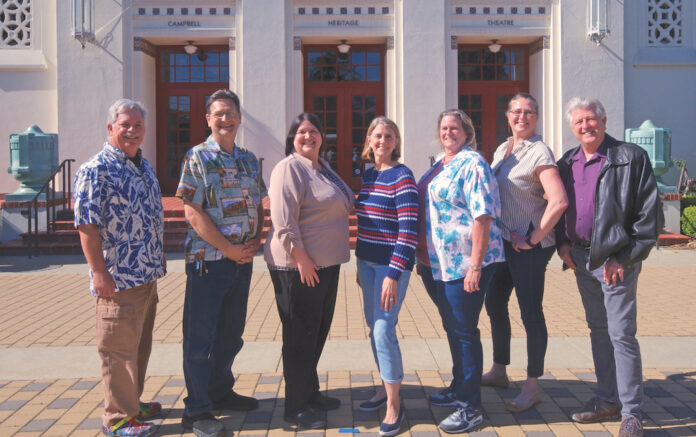
Friends of the Heritage Theatre welcomes new board members
Friends of the Heritage Theatre (FOHT), a nonprofit organization dedicated to community awareness, community access and fundraising on behalf of the historic performing arts venue in Campbell, welcomes two new members to its Board of Directors: Ed Gordon (Campbell resident, retired) and Nandini Acharya (Campbell resident, attorney).
The “Friends” are continuing the search for additional members who would like to contribute to their mission.
To help ensure the theater continues to be a magnet for the community following their closure due to the coronavirus, the FOHT began the planning stages for new projects to support and enhance the venue after reopening in 2022. They also continue to raise money for the theater through concession sales and special programs.
Residence in the city of Campbell is not required to serve on the board.
FOHT Board President Samantha Ince added, “Our board members are passionate about the arts, the City of Campbell and the success of the Campbell Heritage Theatre. Prior board experience is welcome but not required. This is a great opportunity to actively engage with and support the theater and surrounding community.”
For information about Friends of the Heritage Theatre or to learn more about becoming a member of the Board of Directors, email fo*********@***il.com or send a letter with your contact information to Friends of the Heritage Theatre, 1 West Campbell Avenue, #C32, Campbell, CA 95008.

Supervisors act to protect residents from wildfires
At County Supervisor Joe Simitian’s urging, the Santa Clara County Board of Supervisors unanimously directed staff to enter into a contract for enhanced and expanded defensive space brush chipping and debris removal services along public access areas to address the wildland fire risk in the county’s fire-prone areas on its western side.
The Board’s action, which was made in response to a request from Simitian in April, will allow the Central Fire Protection District Fire Chief to negotiate a new $1.25 million, five-year contract with the Santa Clara County FireSafe Council for defensive space brush chipping and debris removal services for owners and residents of properties located along public access areas in Central Fire’s Wildland Urban Interface area (WUI). The contract also allows the FireSafe Council to perform roadside vegetation treatments to maintain shaded fuel breaks and evacuation routes.
“The contract with the FireSafe Council will reduce hazardous fuels and increase public safety by creating more fire-resilient properties along public access areas in the WUI,” said Simitian, whose District Five includes the entirety of Central Fire’s territories. “And it will ultimately decrease the potential for the catastrophic loss of life and property in a wildfire.”
Simitian is supporting the FireSafe Council’s request for $60,000 in PG&E grant funding for its community chipping program operated in the WUI areas of the county, which includes the Santa Cruz Mountains. This funding source would allow work to be done beyond the public access area targeted by County funds, and will further help local residents in their efforts to create and maintain safe defensible space by processing or disposing of brush and tree branches.
Simitian noted, “While this is good news in terms of keeping our area safe from fires, we need even more in terms of resources, which is why I’ve asked PG&E to approve the FireSafe Council’s request for grant funding for its community chipping program. With the devastating storms that hit our mountain communities so hard this past winter, our mountain residents especially need and deserve PG&E’s support.”
Established in 1947, Central Fire’s boundary includes the cities of Cupertino, Monte Sereno, a portion of Saratoga, the town of Los Gatos, as well as rural unincorporated lands in western Santa Clara County, including the Santa Cruz Mountains. The District provides service outside its boundaries by contract to the cities of Campbell and Los Altos, the Los Altos Hills County Fire District, and the Saratoga Fire Protection District. In total, Central Fire provides emergency response to over 225,000 residents in these communities.
Through Central Fire’s Pre-Fire Management and Wildfire Resilience Program the District partners with local, state and federal agencies to develop pre-fire management solutions and to implement projects to reduce wildfire losses. The program includes an eight-member Fire Fuels Crew as well as a Community Wildfire Specialist who works with local groups and supports community leaders in pre-fire wildland management efforts.
Blood donations needed for busy summer months
The American Red Cross is asking people to book a time to give blood or platelets now to address a recent drop in donation appointments that could lead to fewer transfusions for patients in the weeks ahead.
Type O blood donors are especially needed to ensure a strong blood supply.
In Los Gatos, a blood drive will be held June 9 from 9am to 3pm at West Valley Muslim Association, 16769 Farley Road.
To make an appointment, download the Red Cross Blood Donor App, visit RedCrossBlood.org or call 1.800.733.2767.
Those who come to give in June will receive a $10 gift card by email to a merchant of their choice. Plus, they’ll also be automatically entered for a chance to win a backyard theater package including a projector and screen, projector tripod, smokeless firepit, Adirondack chair set and a movie night snack package.
Summer reading program begins
The Santa Clara County Library District (SCCLD) is inviting everyone to join the free summer reading program, “Find Your Voice.”
Throughout the months of June and July, SCCLD libraries will host a lineup of programs for children, teens and adults. Participants can look forward to performers, arts and crafts, book clubs, speakers and more.
“According to the California State Library, Summer Reading programs can help children develop skills in art, science, math, technology and literacy, which helps to maintain what students learned through the school year,” County Librarian Jennifer Weeks said. “These free programs also help participants socially, as they build connections within the community, to each other and their libraries.”
A recent study by the Northwest Evaluation Association found that, on average, students in third to fifth grades lost 20% of their school year gains in reading, and 27% of their gains in math during the summer months. Younger children (Grades K-2) and those from low-income families are more disproportionately affected by the so-called “summer slide.”
To take part in the summer reading program, library patrons can register at sccl.beanstack.com/reader365, and log their read books and completed activities. Participants can earn a prize for reading five books and completing an activity this summer.

All cities in Santa Clara County now have suicide prevention policies
Every city in Santa Clara County has now formally adopted a suicide prevention policy. The development is a result of years-long work by the County of Santa Clara Behavioral Health Service Department’s (BHSD) Suicide Prevention Program.
Santa Clara County Board of Supervisors President Susan Ellenberg called it “a big step in addressing mental health and opening dialogue about something impacting people of all ages, cultures and backgrounds.”
“Suicide prevention policy adoption by each city is a powerful public statement of our communities’ growing focus on mental health,” Ellenberg said. “Our county takes great pride in this as we once again lead by example for other counties and communities, showing that this prioritization at the local level helps save lives.”
With support from suicide prevention stakeholders, Suicide Prevention Oversight Committee co-chair Vic Ojakian led the effort advocating for city suicide prevention policies through work with local and state government representatives, officials and staff. The policies promote suicide prevention in local communities and increase collaborative efforts with the County’s Suicide Prevention Program, helping to fight the stigma against suicide and save lives. Most city suicide prevention policies in the county were adopted unanimously.
“Cities are not required to have suicide prevention policies. Working with the cities to pass suicide prevention policies was a long process but one that we feel was part of our commitment to strive to keep our communities healthy,” Ojakian said.
Local suicide prevention policies ensure that cities collaborate and engage in suicide prevention best practices, such as the following:
• Acknowledge suicide as a public health issue
• Support suicide prevention strategies
• Educate residents on suicide, its warning signs, and where to seek help
• Establish and follow formal procedures to share resources and follow safe messaging best practices when communicating with the community
• Adopt and activate postvention protocols when a suicide occurs in the community
In the cities of Palo Alto, Morgan Hill and Milpitas, passage of suicide prevention policies led to the establishment of city-level suicide prevention taskforces that work with the County’s Suicide Prevention Program and expand efforts to the cities.
Following the County’s adoption of a suicide prevention policy in 2010, cities began passing their own policies beginning in 2012. By the end of 2020, seven city policies were in place. Then in 2021, six more were passed, with one more coming last year. The final city-level policy was formally adopted in February.
Established in 2010, the County’s Suicide Prevention Program has the mission of reducing and preventing suicides in Santa Clara County. The program works to achieve its mission through various community activities, including providing crisis intervention services; conducting public awareness campaigns and community outreach; providing mental health and suicide prevention training to professionals and the public; partnering with schools to strengthen suicide crisis response and prevention; and providing grief supports following suicide deaths in the community.









